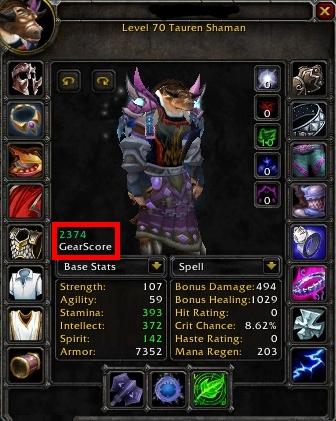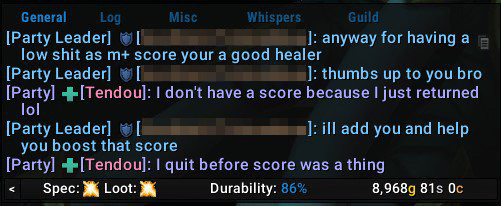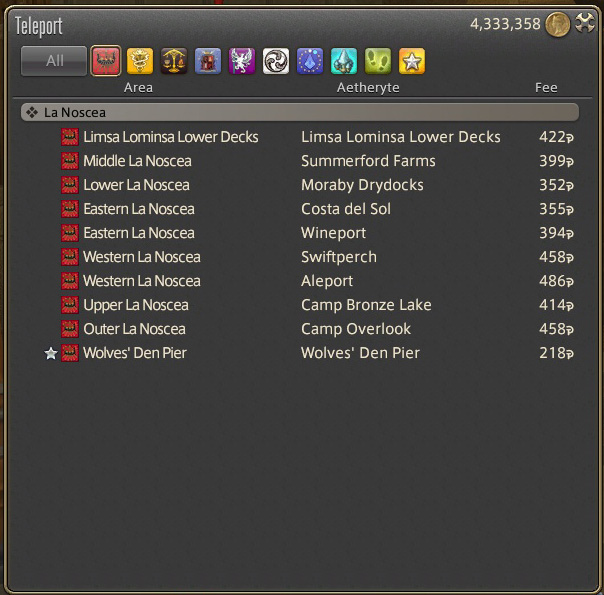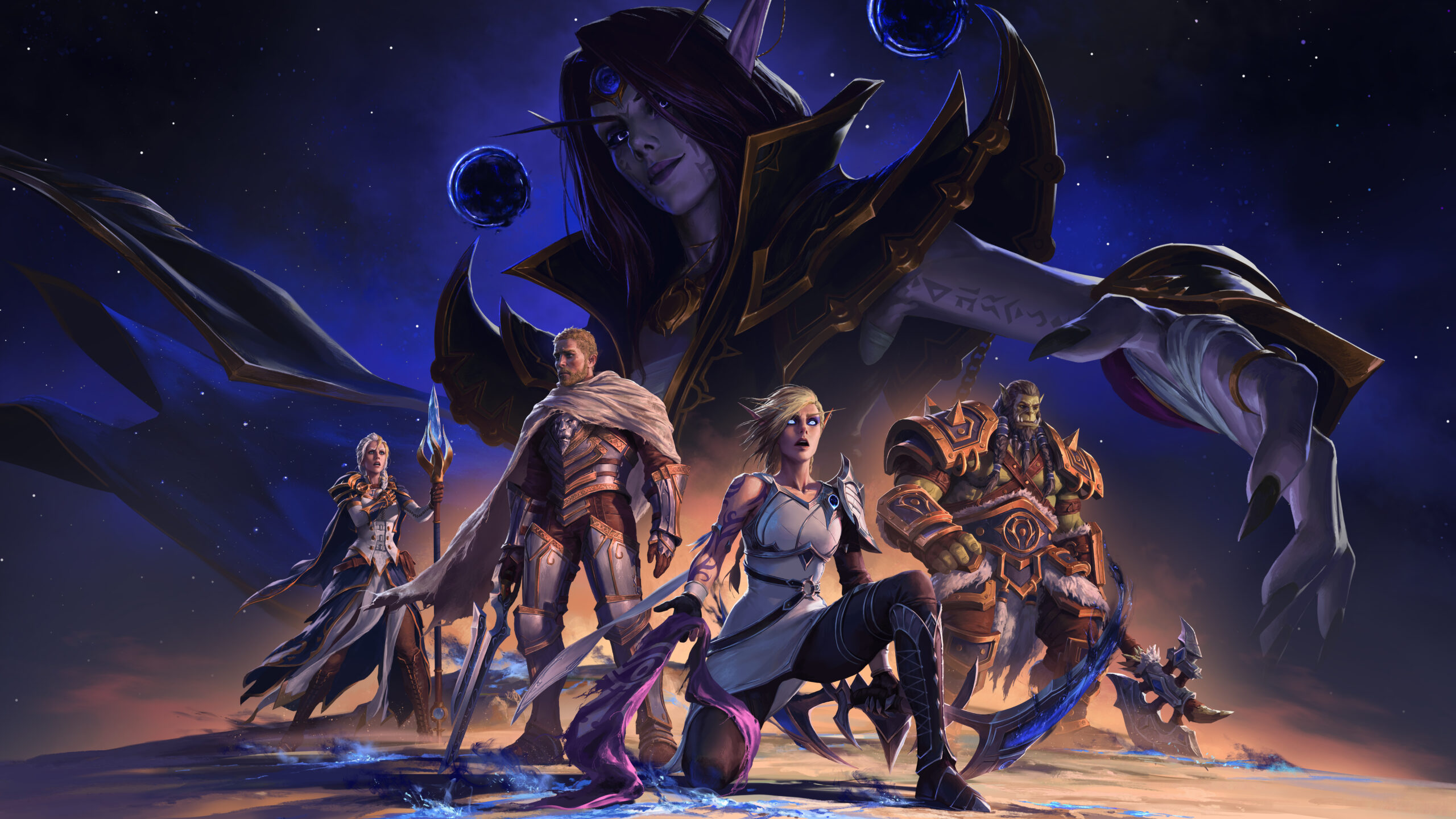MMORPGs are something that I’ve always been fascinated about, it’s one of the few video game genres where I’m kinda decent at. It was through MMOs that someone like me, a man that always lived on the fringes and never had a regular ‘social’ life, was able to connect with others and establish friendships that transcend cultural and ideological barriers—friendships which still hold strong to this day.
They’re certainly not for everyone, and if you deconstruct them, they’re essentially all about numbers. Players press buttons (often in sequence) to deal numbers that reduce an enemy’s numerical health value from 100 to 0 percent. Players then receive rewards that increase their stat values, making them able to deal bigger numbers and thus, allowing them to face enemies that have higher numbers.
But there’s more to MMOs than just pressing buttons and watching numbers fly by. Beyond the gear spreadsheets, the best in slot lists, and all the mathematical foundations of their combat mechanics, there’s a genre that emphasizes exploration, socialization, team work, and combining a character’s individual strengths and roles with that of others in order to succeed against the game’s challenges.
Or at least that used to be the case.
The roots of my MMO pedigree come from Ragnarok Online, a charming game that certainly was a product of its time. I never had the monetary means to partake in some of the golden era ones such as Star Wars Galaxies (before the whole NGE fiasco), Everquest, City of Heroes and what have you—not to mention that foreign currency control laws have plagued Venezuelans since 2003, so paying for these kind of services was always tricky for regular people such as myself.
Advances in technology and infrastructure have brought many wonders to the genre, but at the same time, these modern conveniences and features have killed much of the ‘magic’ that made MMOs so unique and endearing to play. In many cases, the ‘quality of life’ improvements and streamlining of procedures have caused detrimental effects that have cascaded over time—going as far as to changing the collective mentality of the playerbase and their approach towards the games themselves for the worse.
And yes, World of Warcraft ended up doing more harm than good to the genre as a whole from the moment that everyone began to desperately chase the Blizzard cash cow. Therefore, I will be illustrating what I perceive are the genre’s current problems through the elephant in the room, because whether you agree or not, WoW is largely responsible for the current state of the MMOs—the ground zero for many of the problems that unfortunately spread throughout the genre’s incessant desire to replicate, match, and even surpass WoW’s success.
A diminished sense of exploration and journey
The idea of you being a simple adventurer in a vast shared world is no more. Long are the days when you created a character and then you were thrown into a world that was yours to explore, travel, kill, and die as you saw fit.
Today, everything is manufactured and crafted around on-rails thematic experiences where there’s little room for player agency and choice. Certainly so, there are exceptions in games such as Elder Scrolls Online, where there’s a modicum of flexibility in how you approach the world and the journeys that you decide to undertake—I’m speaking in a more general sense about the MMO genre as a whole.
Now it’s all about following the flashy lights and minimap breadcrumbs, padded quests that make you go from point A to point B. Why would you even waste time checking out that nice and calm shore when the quest required to progress is pointing you in the opposite direction? Why even go there if there’s no loot in the first place.
Don’t think, just let the waymarks guide you towards your next quest or cutscene until you reach max level.
Travel was often a crucial factor in early MMO games, it gave a broader sense of scope and grandeur to your adventures, I mean, a group of people spent plenty of time developing and sculpting a world for you to explore and traverse, right?
Solutions that allowed players to quickly traverse through the game’s world were something that in the past was left to the community to work around, an often tacit cogwheel in the broader social aspects of MMOs of yore.
In Ragnarok Online’s case, for example, the Acolyte class and all of its branching class paths had access to a Warp ability that would allow them to instantly teleport players to up to four destinations of their choosing—so players had to choose which destinations were more beneficial for themselves and their friends/community. In WoW’s case, the Mage class was often praised (and tipped) for their portal abilities, to the point that they would, in a way, become unsung heroes that provided a much welcomed community service.
All that is now often replaced by fast travel menus and instant teleportation. Final Fantasy XIV almost completely nullifies travel once you reach a new zone for the first time and attune to its Aetheryte (teleport waymark). Once you do that, going back and forth is best done through a teleport window which you will be using a lot. Instant teleportation is even used to move to and from different points in each of the game’s city hubs.
Phasing or sharding tech help leverage server loads in crowded zones and does make the case for a smoother client performance, but at the same time, it isolates and segments the playerbase, further diluting them and, more often than not, contributing to the feeling of player isolation in the world, as you feel like there’s barely anyone else running around.
Blizzard, through the ‘World Quest’ system introduced in World of Warcraft’s Legion expansion, sought to get players out of the hub cities and into the world. This could have perhaps been the start of a solution had the quests themselves not been daily chores and had they given more thought about making the world less static and more ‘livid’ through more varied and less predictable events—something Rift kind of tried to do and, in a certain way, Guild Wars 2 as well. In any case, WoW’s World Quest system was severely gutted in the latest expansion, and now there’s even less incentive to go out there and do stuff.
MMOs nowadays have become 100% soloable outside of dungeons and raid bosses, to the point that you’re basically playing an always online single player game, pushing aside the multiplayer aspects of the game. Furthermore, the fact that all answers and solutions to the ‘tricky’ quests are one Google search away have further hindered the need to communicate with others ingame. Why ask for directions when the game throws a dozen arrows and breadcrumbs at your minimap — and if you still can’t figure it out then just alt tab and get the answer.
LFG and automated socialization
Socializing and grouping with strangers, a core aspect of MMOs, and something that was expected of players during the course of their journeys, is now automated by matchmaking menus and queues.
We live in a society world that’s more interconnected than ever before — paradoxically, as people around the world became more and more connected with each other, MMORPGs, which were all about connecting with other players, became more antisocial as time went on. Whether it’s dungeons, raids, or world encounters, MMOs are designed so that you have to group up with others to tackle their content, they are, after all, ‘massively multiplayer’ online games and not single player experiences.
The advent of ‘looking for dungeon’ systems completely automated the large bulk of the dungeon grouping experience throughout one’s leveling and initial endgame gearing. It was, perhaps, the biggest double-edged sword to the genre as a whole. I’m sure it was created with the best of intentions, to help players that are either time starved or have trouble partying up with others be able to engage in group content due to social stigmas and other types of impediments, hoping to make the game’s content more accessible to a broader audience.
This sterile automation has reached a point where you simply queue up and get teleported to the dungeon alongside a couple strangers that have no reason or need to say a word to each other—because statistically, chances are that you will never ever interact with them in your life again. It was a weird feeling for me when I played FFXIV and people at least said hello to each other, because a simple ‘hello’ is something rare to find in WoW these days outside of premade group setups.
Other players might as well be NPCs for that matter, and it wouldn’t make any difference beyond the potential lower performance of a bot versus the human wit. That DPS isn’t cutting it? Just vote kick him, the system will send you a new one in a manner of seconds, same with the healer or even the tank.
In a time before dungeon matchmaking and way before cross-server gameplay was technologically feasible, communities were able to flourish better within each game server, no matter how big or small, as people had to, you know, talk to each other to form groups. Some of this still remains in games that offer non-combat content, but in a dungeon or raid environment, well…
Sure, all of this can and is solved by joining a guild, and you should definitely join one, but even in guilds much of the former social camaraderie is nullified and set aside in favor of raid logging, killing bosses, and getting loot. Yes, I reiterate, once you find the right group of people for you it all gets better, but until you do, don’t expect much.
Link achievement and muh score
As I said at the start of this post, this is a genre about numbers, so don’t be surprised that players will try to find numerical ways to measure their power levels.
Your determination and sportsmanship is now summarized and tallied by parse logs that assesses your encounter performance with millimetric precision. Your individuality as a person among group content is superfluous—you’re just an item level, a percentile parse, a bar in a dps meter, and a dungeon clearing score in the eyes of a stranger.
Achievements tend to act as an entry barrier for most pick-up groups in WoW, you gotta link an achievement to enter a group to kill a boss that gets you the achievement. Third party score ranking websites that were first envisioned to measure one’s skill now determine a player’s social hierarchy across an entire region—in many cases, these supposed ‘feats of strength and skill’ bear no true meaning, as they can be straight up bought with money via boosting services (certainly so, anyone with a keen eye won’t be fooled by these ‘boosted’ players).

This really became a real problem during WoW’s Wrath of the Lich King expansion, when the achievement system was introduced to the game and the original Gearscore add-on was unleashed upon the world (of Warcraft). The addon assigned a numerical value based on the quality of your character’s equipment—and of course, the erroneous conception of ‘higher item level = higher skill’ spread like wildfire.
I remember having to carry a tank trinket that sucked just because it boosted my Gearscore, then I’d swap to the ‘lesser’ but better in practice trinket after joining a group. The whole Gearscore thing was flawed from the start because during those days, GDKP runs were the new hotness (basically: people getting carried and buying loot with ingame gold), so you had a bunch of whales decked in great gear (and thus high gearscore) performing really bad in a raid.
Blizzard even joked about it during one of their April Fools jokes (back when they still had a sense of humor), but they knew that this was something that unfortunately had now become part of the game. Their solution was to render the Gearscore addon obsolete by incorporating item level in characters’ stat sheets, and that snowballed to other games.
To this day, groups in WoW will demand you have an item level that’s actually higher than what the raid in question drops, because most people simply want to get carried.
Since achievements and item levels do not necessarily correlate with a player’s actual performance, an actual solution to assess a player’s skill was needed—enter, parse log websites.
As a tryhard myself, I’m not gonna de-merit them, because they are handy tools that offer you insight in how to fix mistakes, improve, and do better while measuring your performance against others of the same class. However, there will always be some that take it to the extreme, to the point of becoming obsessed with their percentile ranks—their idea of fun and enjoyment is no longer the game itself, it’s all about that ephemeral parse that eventually gets deleted off the website.
Now, raider.io is the more egregious one. For those unfamiliarized, it is a website that is primarily used to rank Mythic+ dungeon performance. Instead of a percentile score, it uses its own system to assign players a numerical score—basically what Gearscore was used for, but actually based around actual player performance.
This single measurement is grossly misused in WoW, and if you wanna hyperbole it, it functions as an amalgamation of every ‘score’ system there is: Chinese Social Score, American Credit Score, Venezuelan Fatherland Card, et al.
I’ve had cases where people would ‘wow’ at me simply because my character’s ‘low score’ would not correlate with my actual performance—I was exceeding it, and that anomaly can’t be, right?
The truth was much simpler, I had taken an absence from the game and thus was not keeping up with the score rank, and I never cared about it.

I’ve never obsessed much with it, it’s whatever for me, I’ve always been pretty confident in my abilities despite a ‘low score’ that I had no interest in bumping. Besides, I don’t have the time these days to keep up with it, and I’ve never been a real slave to the meta (hence why I played Protection Paladin during Burning Crusade).
Same problem here with item level, people demand you have a score that’s much higher than the one expected for a given Mythic+ key because most people just want to get carried.
Final Fantasy XIV ‘solved’ the item level problem through the severely structured nature of its game systems. As item levels are tightly rubber banded and kept in check. Furthermore, item level is irrelevant in dungeons and in many times of ‘non standard’ content, as everyone is scaled to an even field item level-wise.
The ‘link achievement or no group for you’ part is automated by its own premade group finder tool, in the form of a toggle that can be enabled when creating a group listing. As for logs, they became a necessity during Heavensward and their tightly tuned boss encounters, but they remain, to this day, a borderline gray area in their Terms of Service—to be more specific, the tools used to generate the logs, not the parse website itself.
Whether you think all of this is a problem or not is irrelevant, the cat is out of the bag with regards to all of this. It’s perfectly fine to strive towards being better and performing better in the game, after all, I am still a tryhard, just don’t get consumed by the obsession of having a higher number to the point that you forsake having fun—Otherwise you end up having extreme cases such as WoW classic, a game that’s all but solved, where people desperately need to optimize every single number, collecting world buffs and doing everything they can to do maximum dps—only to end up spamming 111111111111 as a mage during a raid.
Over reliance on add-ons and tools
Addons do help enhance one’s player experience, and in many cases, they serve to complement any deficiencies on the game’s default UI. Boss mods and other types of similar addons have existed in WoW since before I started playing it; they’re ancillary and optional things you can install to aid you in your encounters, which is perfectly fine. The problem arises when developers begin creating encounters assuming that they will be cleared with the help of the addons themselves.
So instead of enjoying the spectacle of the scripted boss encounter and the challenge it presents, you simply are bracing yourself for the next ability in the spell timer list, and reacting appropriately, moving when the large WeakAura tells you to, and ultimately making the entire boss experience more mechanic than it should be.
In lieu of having official addon support FFXIV tackles this by having a consistent visual language for the boss mechanics, stack/spread markers are always the same no matter what, which, in theory, should eliminate the need for a ‘Deadly Boss Mod’ type of addon—except it quite didn’t, as gray-area ToS tools do exist that replicate these functions, sometimes going far beyond the original WoW tool’s capabilities.
Not much else that can be done here, as the nature of learning PvE encounters rely on repetition, and repetition is predictable, so tools like this will continue to exist regardless and thus their need, but they’ve become a crutch to encounter originality for sure. There’s a point where you become very reliant on these tools, to the point that when one of them breaks due to a patch you don’t know what to do.
Class homogenization
The whole point of choosing a class is to pick one that not only suits your playstyle, but provides a unique flavor to the role, one that you feel comfortable with. Each class should be unique, with its own strengths, weaknesses, and quirks or gimmicks. It is by accepting your class’ own strengths and deficiencies that you become a better player.
There will always be one inalienable truth, some classes will exceed others depending on the context you throw them at. The new development mantra dictates that every class should be able to function in a way that they can participate in every content, which is perfectly fine, because not being able to participate in a boss fight because you picked the wrong class is kind of bad design in all honesty.
However, in Blizzard’s case, their obsession to make everyone equal came with a high cost. By removing that which makes each class unique you have a scenario where every class feels like reskins of one another, with the same abilities albeit with different vfx.
Back in my day (insert boomer joke here) classes felt more unique. In Ragnarok Online some classes were simply built better for PvP, others for PvE, and some were best suited for farming or helping others grind. During the Burning Crusade expansion a protection paladin had to accept that a warrior was the better main tank, even if it could perform the same functions in theory if you put in the effort (getting a total of 102.4% defense rating, for example).
This didn’t mean that protection paladins had no use, as they had their own strengths, they were better at aoe tanking, which made them superior in this regard. As time went on, every tank class became quite the same-y because they all needed to perform relatively similarly across all scenarios.
A better way to exemplify this is through the current tank jobs in Final Fantasy XIV. Patch 6.0 made all four tank classes fundamentally the same, with the same core toolkit (1 single target combo, 1 AoE combo, the same basic set of defensives, 1 gap closer, etc), their only difference being their individual rotational damage dealing gimmicks, slight variations in utility, and the way their invulnerability skills work.
Another example I vividly remember is the Warlords of Draenor iteration of the Shadow Priest specialization. You were forced into picking the Clarity of Power talent, a playstyle that made you forgo the original Shadow Priest gameplay in favor of one that was closer to the mage class. Sure, it worked, and you did damage, but you lost all originality by doing so.
Group buffs and utility added even more flavor to classes. The perceived lower damage of a class could be offset by the utility they bought, and that isn’t always initially reflected in the damage meters. Paladins had access to plenty of buffs in the past, and most of that is now gone, it’s funny because I do one one WoW paladin shirt, and all of the utility buffs featured on the design are now gone from the game.
Blizzard has been at a constant fight with themselves in order to undo the homogenization that they inflicted upon the game, with some success here and there, but always hindered by their own choices. Yes, ability bloat has and can be a problem in many games, but that’s a balance that all developers should strive for while keeping classes as varied as possible.
Casuals, hardcores, and participation
From a development perspective, there is credence in making sure that you design content that will be consumed by more than just the top 1% of players, ensuring that every player can potentially enjoy all forms of content is fine—their money is worth just as much at the end of the day.
Catering to the ‘casuals’ however, can often have the unintended consequence of making them very complacent when it comes to difficulties. It’s one thing to have an ‘easy mode’, but when you start lowering the bar then the collective will stop striving to improve—the tryhard in me will always tell you to keep pushing yourself towards higher difficulties, because I’m sure that you’re more than capable of doing it.
Exclusively catering to the ‘hardcore’ side isn’t the solution either, or else you have another Wildstar in your hands, a now dead game that had so much more potential had they not developed themselves into an early grave by trying to be the ‘hardcore mmo.’
I don’t think the solution is to simply provide different difficulty modes and have the players stay in the one they feel the most comfortable with, where everyone gets their respective good boy points. Make it a properly and progressively harder smooth curve and people will keep pushing themselves until they succeed.
Shorter attention spans and the desire for instant gratification
People want it, they don’t know what they want, or if they even need it in the first place, but they want it now—to the point that they’re willing to pay exorbitant amounts of money for it (just look at gacha whales).
A fundamental part of MMO characters is growth and progression—the journey of your character, climbing from a newbie level 1 all the way into the higher spheres of power. You spend hours upon hours grinding experience to level up, and then more hours to acquire gear that boosts your performance. More often than not this treadmill never ends, and is reset with each new content patch (cause that’s the whole point), but for a brief moment you can attain that ‘it’s finished’ build.
Some people find enjoyment in purchasing a model, and spending hours/days sanding, priming, painting, assembling their Gunpla, the end result being something to be proud of. Opposite to this are others who would rather just purchase an expensive figurine and be done with it.
Yes, some games have been egregious in their grinds, but now we’re at a point were people are happy to pay for character boosts to skip parts of the game (ie. the leveling process) because they need that instant gratification.
There are now plenty of games that offer a more instant ‘drop in/drop out’ sense of gratification, with much less time investment needed to accrue rewards—and that’s where the money is at.
That is something that unfortunately, MMO game developers need to solve, because let’s face it, not everyone has that much free time these days.
WoW expects you to play every single game lest you fall behind in its timegated progression thresholds. When Shadowlands launched my guild expected me to have both a main character and at alt at max level by week one, all caught up in Renown and Soul Ash. Me, as time constrained as I am these days, managed to pull through—only to end up severely disappointed at Shadowlands as a whole (more on that later on a different article)
FFXIV offers you an opposite, more controllable, albeit not as lasting tier content, and a more manageable list of weekly chores. If you’re good at the game then ~8 weeks of raiding is all it takes for you to completely gear up and ‘finish’ a tier. If you don’t care about the best in slot list then it takes even less weeks.
This might leave some more hardcore players starved for content, in that case just unsubscribe, play other games, do other things, and then come back once there’s a new tier—I find that much healthier than being forced to play every single day.
Stagnation and lack of innovation
Let’s be real, the genre became extremely stagnant in their obsession to make the ‘WoW killer.’
This is exactly where it all went south in the genre, all they had to do was simply make something that wasn’t WoW—then again, everyone wanted to make as much money as WoW, to the point that they just copy-pasted the formula.
Even FFXIV has its own version of the WoW formula—ironically, it’s more faithful to it than current WoW is. By the time developers began to steer away from simply copying WoW, it was too late, the damage was done.
Games that didn’t straight up copy WoW had their own shortcomings and monkey-paw esque flaws. Guild Wars 2? Story and endgame. PSO2? Took eight whole years to properly release in the West, and by then its f2p model feels outdated.
A stagnated genre devoid of innovation can’t compete against the Battle Royale, MOBAs, and other, more ‘instant gratification’ genres, which, suffice to say, have their own ‘we need to copy x’s formula’ problems.
Changes in playerbase mentality
Maybe I am phasing out of time, maybe I am really a boomer, and I no longer fully fit into this genre, but what better way to exemplify the degradation of MMOs if not through the collective culture of the current generation of players.
I know the world feels jaded and cynical these days, that doesn’t justify nor gives reason to the playerbase to be so mechanical, so boring and sterile. The internet used to be more cheerful and less serious, back when there wasn’t any new outrage and a new mob cancelling something every day.
The ‘community’ content today is no longer mainly centered around funny videos or parodies, it’s all about the tools that you need to optimize your numbers, simulating your theoretical performance with each new piece so that you may continue to be a slave to the meta.
This mechanization does not limit itself to the core elements of gameplay, the social and creativity aspect of it. During earlier days of the game, it was common to see parody songs, machinima videos, and all sorts of content that had nothing to do with the game’s combat mechanics—certainly so, some would be deemed too offensive and even ‘racist’ for today’s sensitivities, even if their only crime was to make note of some of the biggest issues in the game through, such as the classic ‘ni hao – a gold farmer’s story’
This is going to sound cliche, I know, but I’m sure more than one would be outraged if this video was released today:
I’m not trying to say that there are no longer people out there creating amazing fan content, because that’s not the case. Despite all that there’s still plenty of fantastic artists, musicians, and writers that have a deep passion for their favorite games, creating amazing drawings and commissions, remixes, and in-universe stories—it’s just that much of it tends to be obfuscated by the cynicism and desire to be the best number dealing ‘pumper.’
There’s a few more topics that I’ve deliberately omitted this time around, some of which are very WoW centric and that I will be covering in another entry soon (PvE esports, for example). I’d love to hear from you and your insight in this matter.
The popularity of MMOs have suffered greatly throughout the past years due to the ever shifting dynamics of a video game industry that is less innovative with each passing day—where developers keep shooting themselves in the foot just to appease shareholders and chase ideological fads and quotas. It’s a miracle that the genre as a whole managed to survive the MOBA surge (RTS games fared worse), the Battle Royale fad, and other more ‘instant gratification’ experiences that include flavor of the month games such as ‘amogus’ and mobile gacha games.
This is a genre that needs to reinvent itself, a genre in a dire need for a renaissance moment, and one that I’m very fond of, because like I said, it’s one that helped me not only sharpen my English further, but helped me connect and interact with others.
Until the next one,
-Kal





1 Comment
World of Warcraft: Shadowlands — the Kaleb review | ckaleb[dot]com · May 7, 2021 at 4:27 am
[…] of Warcraft was, is, and continues to be one of the main culprits of the stagnation of MMOs. For all its flaws, it is still the de-facto money-printer of the MMO genre. It’s the MMO with […]
Comments are closed.